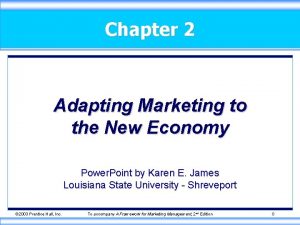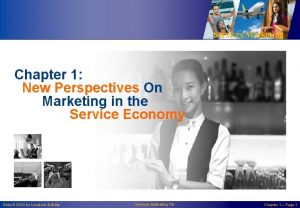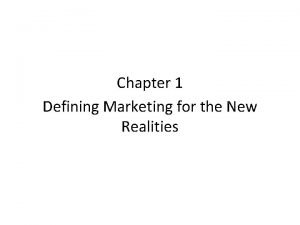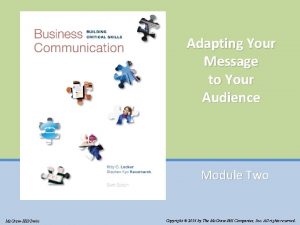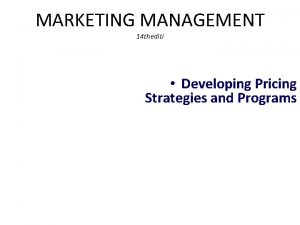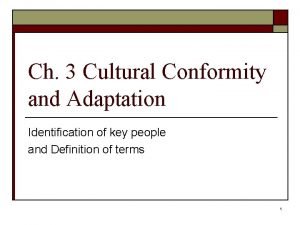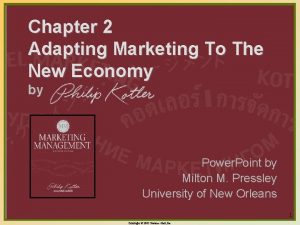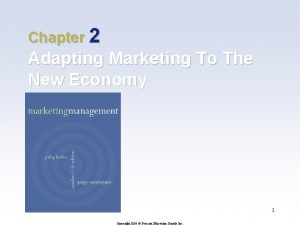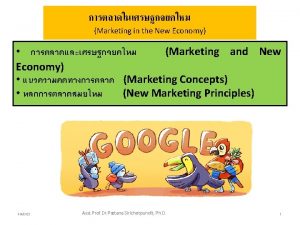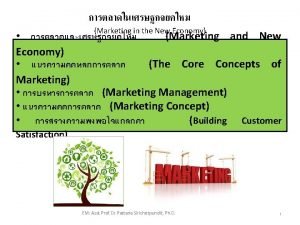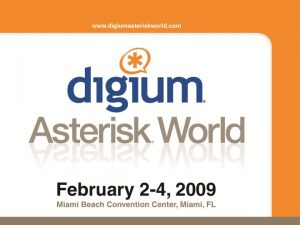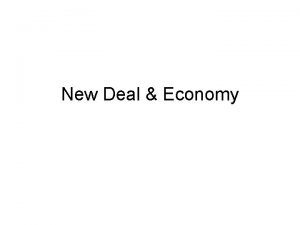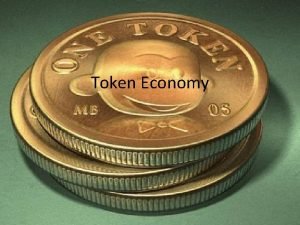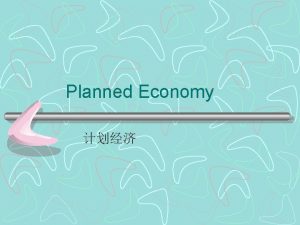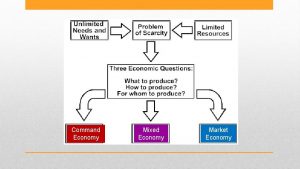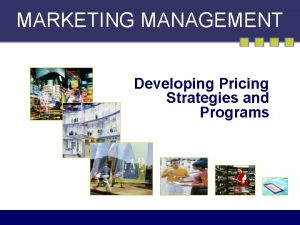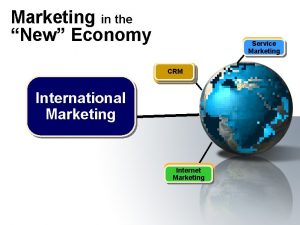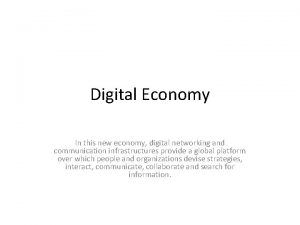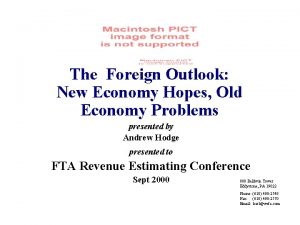MARKETING MANAGEMENT Adapting marketing for the new economy


























- Slides: 26

MARKETING MANAGEMENT Adapting marketing for the new economy and Creating Customer Value, Satisfaction, and Loyalty Kotler Keller

Major drivers of the new economy • Digitization and connectivity • Disintermediation and re-intermediation • Online middlemen • Customization and customerization • Individually differentiated products vs. personalized products and channels • Industry convergence • Blurring of boundaries • Disney, Kodak etc

Old Economy vs. New Old Economy New economy Organize by product units Organize by mkt. segments Focus on profitable transactions Focus on customer lifetime value Focus on shareholders Focus on stakeholders Marketing does the marketing Everyone does the marketing Build brands through advertising Build brands through performance Focus on customer acquisition Focus on customer retention No customer satisfaction measured Measure customer satisfaction and retention rate Over-promise, under-deliver Under-promise, Over-deliver Look at the financial scorecard Look also at the marketing scorecard

E-commerce • E-commerce vs. e-business • Online transactions • Four major internet domains – B 2 C: – B 2 B: web procurement • Which is greater? Forrester and Gartner – C 2 C: information creation • Chat-rooms, blogs, IM, WOM vs. WOW – C 2 B: • Email suggestions and complaints

E-commerce • • • business-to-employee (B 2 E) business-to-government (B 2 G) government-to-business (G 2 B) government-to-government (G 2 G) government-to-citizen (G 2 C)

Organizational Charts

Customer value and satisfaction • Customer perceived value • Difference between the prospective customer’s evaluation of all benefits and all the costs of an offering and the perceived alternatives. • Total customer value • Perceived monetary value of the bundles of economic, functional and psychological benefits customers expect from a given market offering.

Determinants of Customer-Delivered Value Customerdelivered value Total customer value Product value Total customer cost Monetary cost Personal value Energy cost

Customer value and satisfaction • The real price of anything is the toil and trouble of acquiring it • Satisfaction: • Feeling of pleasure or displeasure resulting from comparing a product’s performance with the expectations.

Loyalty A deeply held commitment to re-buy or re-patronize a preferred product or service in the future despite situational influences and marketing efforts having the potential to cause switching behavior.

Measuring Satisfaction Periodic Surveys Customer Loss Rate Mystery Shoppers Monitor competitive performance

Countrywide received the #1 customer satisfaction rating from J. D. Power and Associates

Product and Service Quality is the totality of features and characteristics of a product or service that bear on its ability to satisfy stated or implied needs.

Customer Life Time Value • The present value of the stream of future profits expected over the customer’s lifetime purchases.

Estimating Lifetime Value • • Annual customer revenue: $5, 000 Average number of loyal years: 2 Company profit margin: 10% Customer lifetime value: $1, 000

Successful Relationships C. V = benefit/costs Customer Value Customer Performance vs. Satisfaction Expectations Loyal customers Customer Retention

Customer Profitability-Focused Marketing Tier 1: Platinum Tier 2: Gold Tier 3: Iron Tier 4: Lead Heavy users, not price sensitive, try new products Heavy users but price sensitive Spending volume implies no special treatment Cost the company and generate –ve WOM

Framework for CRM Identify prospects and customers Differentiate customers by needs and value to company Interact to improve knowledge Customize for each customer

CRM Strategies Reduce the rate of defection Terminate low-profit customers Focus more effort on high -profit customers

Mass vs. One-to-One Marketing Mass • Average customer • Customer anonymity • Standard product • Mass production • Mass distribution • Mass advertising • One-way message • Economies of scale One-to-One • Individual customer • Customer profile • Customized market offering • Customized production • Economies of scope

Customer Retention • Acquisition of customers can cost 5 times more than retaining current customers. • The average company loses 10% of its customers each year. • A 5% reduction to the customer defection rate can increase profits by 25% to 85%. • The customer profit rate increases over the life of a retained customer.

The Customer-Development Process Suspects Prospects First-time customers Disqualified Repeat customers Ex-customers Clients Members Partners

Levels of investment in Customer Relationship Building Partnership: work contin. with large customers Proactive: regular contact with customer about product offerings Accountable: post-sale service and suggestions Reactive: sells and encourages feedback Basic: salesperson simply sells

Reducing Customer Defection • Define and measure retention rate. • Distinguish causes of customer attrition. • Estimate profit loss associated with loss of customers. • Assess cost to reduce defection rate. • Gather customer feedback.

Cost of Lost Customer • A company has 64 k accounts • It lost 5% of its accounts this year due to poor service. Loss is 3, 200 accts (. 05* 64 k) • Avg. lost acct means a $40 k loss in revenue. Total loss in revenue is $128 million (3, 200*40 k) • If profit margin of company is 10% the total loss for 2009 is (. 10*$128 m)=$12. 8 million.

Total Quality Management TQM is an organization-wide approach to continuously improving the quality of all the organization’s processes, products, and services.
 How to adapt marketing to the new economy
How to adapt marketing to the new economy New perspective marketing
New perspective marketing Athens and sparta were both
Athens and sparta were both What forces are defining the new marketing realities
What forces are defining the new marketing realities How well are we adapting
How well are we adapting What is adopting materials
What is adopting materials Adapting the message to your audience.’
Adapting the message to your audience.’ Adapting to challenges of the micro environment
Adapting to challenges of the micro environment Adapting the price
Adapting the price The process of adapting borrowed cultural traits.
The process of adapting borrowed cultural traits. Adapting the price
Adapting the price Adapting to your audience
Adapting to your audience How well are we adapting
How well are we adapting Adapting curriculum to bridge equity gaps
Adapting curriculum to bridge equity gaps Iso 22301 utbildning
Iso 22301 utbildning Novell typiska drag
Novell typiska drag Tack för att ni lyssnade bild
Tack för att ni lyssnade bild Vad står k.r.å.k.a.n för
Vad står k.r.å.k.a.n för Shingelfrisyren
Shingelfrisyren En lathund för arbete med kontinuitetshantering
En lathund för arbete med kontinuitetshantering Personalliggare bygg undantag
Personalliggare bygg undantag Tidbok yrkesförare
Tidbok yrkesförare Sura för anatom
Sura för anatom Förklara densitet för barn
Förklara densitet för barn Datorkunskap för nybörjare
Datorkunskap för nybörjare Stig kerman
Stig kerman Debattinlägg mall
Debattinlägg mall
